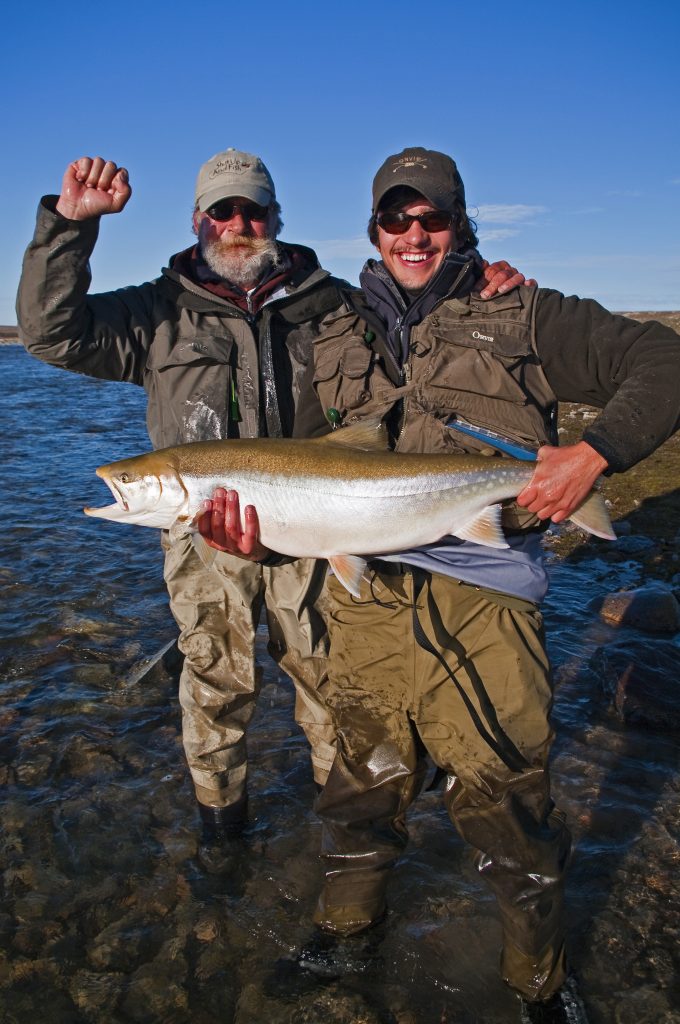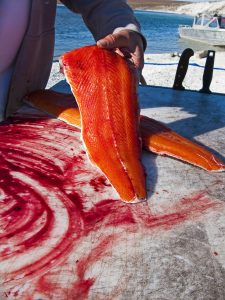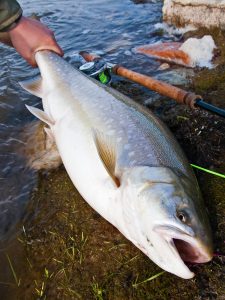The Sea-Run Angle: A Matter of Nets & Hooks
Ekaluk River, Nunavut, Canada
The wild, sea-run Arctic char is a delicious fish, no two ways about it. Its flesh resembles that of salmon, but its flavor is more delicate, trending toward the taste of trout. With the decline of Pacific salmon stocks, particularly from the Sacramento and Klamath rivers, char has made its way onto more and more restaurant menus in California as chefs try to fill the void. So it was, one fall evening two years back at Maverick, a restaurant in San Francisco’s Mission District, I saw Wild Arctic Char listed as a special entrée and was highly intrigued.
Dutifully, I asked the server, “Where does this char come from?”
“From northern Canada. Somewhere in the Arctic, I think,” came the reply.
“Is it sustainable,” I asked.
“Yes, it’s harvested and sold by the natives under strict quota.”
Little did I know, as I savored the first tasty morsel, I was embarking on a path that would lead directly to the very river, in all likelihood, that was home to the fish now adorning my plate. And little did I know that when I arrived, the admirable balance between sport fishing tourism and commercial harvest that had existed for nine years on this river had been knocked ass over teakettle.
As you’ll read elsewhere in this issue, I was very fortunate to have had the opportunity last summer to visit and fish in the Nunavut territory of northern Canada for a special race of these same sea-run Arctic char. I occupied one of 24 possible spots — it’s a brief, two-week season, 12 rods each week — at the Ekaluk River camp on the southeast edge of Victoria Island run by Bill Lyall and Jack Elofsson. Bill is of Inuit descent and a respected community and business leader in the nearby town of Cambridge Bay. Jack hails from Sweden, spent most of his adult life crewing on adventure ships in the Arctic and now resides in Alberta. Bill owns, Jack guides and Camp Ekaluk offers a rare treat: exclusive access to what is probably the largest run of the largest sea-run Arctic char known.
Longtime repeating guests claim it’s the best freshwater fly-fishing on the planet. That’s a significant claim, putting it mildly. But examine the catch records kept since the camp’s inception in 2001 and you might be inclined to think it’s not merely an idle boast. At any rate, as a destination for world-class angling, it’s pretty damn good. The amenities found at high-end wilderness salmon camps and lodges, such as Ryabaga Camp on the Russian Ponoi River, also above the Arctic Circle, may not be there, but for numbers of high-quality, dime-bright fish eager to inhale a swinging fly and drag you back to the salt — for sheer angling thrills — the Ekaluk experience is right up there with any to be had.
On my way into the camp, as is always the case when I’m headed to a river with the intent and distinct possibility of intercepting big sea-run fish, anticipation was full-on. The group assembled in Edmonton, Alberta, on the night prior to arrival. Dinner talk with Don, a guest returning for his second trip, stoked the flame even more. I had just come from hosting two weeks at a tent camp on the main-stem Skeena, where I experienced some of the best steelhead fishing imaginable. I was dead-tired, facing a third consecutive week in a sleeping bag and definitely not getting any younger—I had every reason to be excited at the prospect of a full night’s rest in a real bed. Instead, my mind swarmed with anxious thoughts of the week ahead. I re-sorted all my gear, checked the line-to-backing connections on my reels, tied a half-dozen flies, re-packed and, finally, lay down for a too-short night of fitful sleep.
In the morning, the journey began.
We set out for Yellowknife on a flight operated by Canadian North Airlines. A bold, polar bear graphic on the tail seemed like just the right touch. In the air, conversation buzzed with excitement, centering mostly on accounts of previous years’ fishing and what new rods or flies each was bringing; several had added two-handed rods to their kit this year. When boarding, I noticed a passenger with a copy of Trey Combs’ Steelhead Fly Fishing. I honed in on this one and grabbed the adjacent seat. It turns out Peter was a charter guest; he’d not missed a year since the camp opened on an invitation-only basis in 2001. We chatted about steelhead and spey fishing techniques, but soon were poring through his Ekaluk journal, which contained detailed accounts of all his previous visits. The numbers were staggering. His personal best was a count well over 50 fish — in one day! I won’t cite the exact figure because it’s nearly unfathomable. (I was skeptical, but my incredulity softened when I later observed the intensity with which Peter fished and the dawn-to-dusk hours he put in.) Average days were more like 30 to hand, and average size was about the same in inches. I looked around the cabin. Except for those obviously not going fishing, each had that wild I’m-trying-to-remain-calm-but-I’m-dying-to-get-there look in his eyes. This was going to be good.

Edmonton to Yellowknife; Yellowknife to Cambridge Bay; Cambridge Bay to Camp Ekaluk by float plane; at last the travel was over and it was time to wader up, shut up and fish.
I was not surprised when one of the guests, right off the bat, set his anchor a little too close on a spey cast and impaled his cheek with a very realistic prawn imitation. We were all eager to get a fly in the water. Mike, perhaps, a little more so than the rest! Fishing barbless is optional on the Ekaluk. I don’t know if this No.2 iron had a barb, but I do know I felt more than a tinge of relief when I learned there was a doctor among us. With the level of excitement present the first day in, I imagined he could potentially be a very busy guy. Soon, however, wounds were treated, calamities and anxiousness subsided and all were relaxed and settled into the pleasant rhythm that eventually prevails in any fishing camp.
Catch rates were not immediately high. But no one was concerned. The veterans were getting their fish — I think I heard the number 20 tossed around for Peter the first evening — and the pervasive feeling was that we were most likely a few days ahead of the main push. The days had been sunny and comfortably warm. Agreeable weather, I was told, keeps the fish out in the ocean longer, encouraging them to continue feeding. Their objective, after all, is to pack on as much muscle and fat as possible in advance of the long winter.
The Ekaluk is a short river, just a couple of miles long, connecting a large lake to the waters of the Arctic Ocean. Fish leave the river after the ice breaks and melts in July, go to saltwater to feed, and must get back to the lake, usually by early September, before winter returns the entire region to a block of ice. If the char stayed in the ocean they would freeze solid, since saltwater has a lower freezing point than freshwater. So, typically, when the weather in late August or early September turns bad, the fish hurry back to the river and fishing gets good. All we needed to unleash the frenzy, it seemed, was a strong blow from the north.
Toward the middle of the week, however, the talk began to shift. The fishing was fine, but the catching wasn’t quite right. The trip was not unfolding as expected or as had ever been experienced in the history of the camp. There was trouble in fly-fishing paradise. In fact, a couple of the regular rods registered fishless days. This was unheard of. On the river, extended periods went by without as much as a disinterested pluck. If the fish were there, they weren’t playing along. When they were present, many of those caught were smaller than average. The Ekaluk is known for big, aggressive char — 36-inch fish are relatively common and these can have a girth over 20 inches. Twenty-pounders are anticipated here like the postal service—they’re expected on a regular basis.
No, the main push was not arriving.
Anglers conferred and commiserated alongside the river. Theories and rumors began to circulate. What was happening? What was going on in those buildings around the bend from camp near the mouth of the river? And why did the building up on the lake above the river look abandoned and dilapidated?
Being a connoisseur of the steelhead fly-fishing experience, this level of contact with our finny friends was nothing new to me. I’m used to getting just a chance or two a day. That’s typical. And if I draw a goose egg, it’s nothing to get uptight about. You know, to catch them, the fish have to be there and be willing to play along. It doesn’t always happen, and a lot is not in your control. Anyhow, I was getting five char or so a day, not really keeping a precise body count, and was pretty much happy as a clam. But there was growing unrest in the camp.
Some background: Since the early 1960’s, the rivers around Cambridge Bay have supported both commercial and subsistence fisheries. The commercial operation is jointly managed by the Canadian federal Department of Fisheries and Oceans (DFO) and resource management groups in the local Inuit community. The first commercial gillnet fishery was established on Freshwater Creek, not far from town. In 1962, that operation was moved to the Ekaluk with an annual weight quota recommended by DFO, established at roughly 40,000 pounds. In subsequent years, various harvest quotas were set. Mostly, these quotas were observed, but three years of heavy take from 1967-69 resulted in a drop of the average weight of harvested fish from about seven pounds to about three pounds. Consequently, the fishery was shut down for the following three years to allow the stocks to rebound. This type of cooperative and adaptive management has continued to the present. When DFO research has found harvest levels to be unsustainable, the community has adjusted or even suspended the fishery. Consequently, Cambridge Bay Arctic char stocks, including those of the Ekaluk, have remained robust. Today, as reported by staff at Camp Ekaluk, the harvest quota is again about 40,000 pounds, which they say corresponds to roughly 8% of the total run.
Existing in commendable harmony alongside the commercial fishery and the small subsistence fishery since the early 2000’s had been the recreational fishery at Camp Ekaluk. These often-divergent interests existed for nine years simultaneously, all contributing positively to the local Cambridge Bay economy in what has to be considered a model relationship, albeit on a small-scale, for maximizing regional benefit — until 2010.
What changed? Very simply, the location of the nets.
In all previous years the point of capture for commercial/subsistence harvest was in the lake, above the river. Every fish in the run was available to the sport fishery, and the sport fishing was phenomenal. A few fish were retained each year for consumption at camp, but the camp otherwise has steadfastly adhered to a strict catch-and-release doctrine. Guests do not leave camp Ekaluk toting a 4×6 cooler crammed with fillets and dry ice, though I’m sure many would have liked to do so. During my visit, we ate grilled char, baked char, char gravlax, smoked char, char spread, char salad, char in salads, char on pasta and probably more char concoctions I can’t remember. If someone told me we had char ice cream, I wouldn’t be shocked. It was all good! Steering back to the point — and a simple but concentrated point it is: In this arrangement, all constituents were able to sustainably maximize their own reasonable use and benefit from the resource. Perhaps this was the only such arrangement on Earth. If not, it had to be one of the very few.
This past summer, for reasons I’m not privy to, the commercial nets were set in the Ekaluk’s lower estuary, downstream of camp, just out of our sight. We could barely see the roofs of the processing buildings. Deducted from casual conversation at camp, I’d say our catch rates were only 25% of historical figures. Even if the harvest rate was actually capped at 8% of the run, the repositioning of the net fishery at the entrance to the river had a profoundly negative effect on sport fishing in the river above. The balance of the economic ecosystem in Cambridge Bay had been egregiously compromised.
Back in Edmonton, convening for dinner before going our separate ways, the group discussed the turn of events. Several regulars insisted they would not be back without assurance that the netting operation would be back up in lake. It was agreed, after returning home, all would write to Bill expressing their displeasure and urging action to restore the balance. An informal Friends of the Ekaluk River was formed.

As mentioned, I’m not a “numbers guy.” Even knowing I had been denied the extraordinary angling Camp Ekaluk afforded guests in all previous seasons, I still thought it was a remarkable trip. The land, the people, the river and the fish all left lasting impressions. The overall experience was incredible.
I confess I had conflicted feelings about registering any sort of complaint. I have no pressing need to catch over 20 wild ten-pound fish in a day; if I can’t remember each fish, I feel in some way I’m abusing a privilege. But, in this instance, when the balance seems to be relatively easy to restore, and knowing that when this balance is in place the arrangement represents a model relationship between what are so often competing fisheries interests, I had to add my voice to the chorus. Something definitely had to be done.
Unlike many stories of this nature regarding the well-being of a valuable tourism industry operating in the shadow of an extraction industry exploiting a common resource, this one has a happy “episode conclusion.” I won’t say “ending,” because the story is ongoing, and I hope will never have a definitive end. In a news release posted to the website arcticflyfishing.com, dated October 21, 2010 and titled “Conflict Situation With Net Fishing Operation at the Mouth of the Ekaluk River during the 2010 Sport Fishing Season,” the following appeared:
“An official meeting between the Commercial Operator and Mr. Bill Lyall addressing the conflict was held in Cambridge Bay Wednesday, October 20th, 2010. The manager of Commercial Operation declared this year’s net fishing operation at the mouth of the Ekaluk [R]iver to be an ‘oversight’ by their part and acknowledged the unintended negative effects on the sport fishery. It was agreed upon that both the commercial fishery and the sport fishery would benefit from a peaceful co-existence, as per the previous nine years, and that the commercial operation would make immediate plans for moving back to Lake Ferguson for the 2011 season.”
The Friends of the Ekaluk accomplished their immediate mission. Kudos to Bill and Jack. And kudos to the commercial operators who had the integrity and vision to agree to a cooperative solution with long-term benefits for all involved.
« Previous Post



Leave a Comment
No Responses to “A Matter of Nets & Hooks by Jeff Bright”